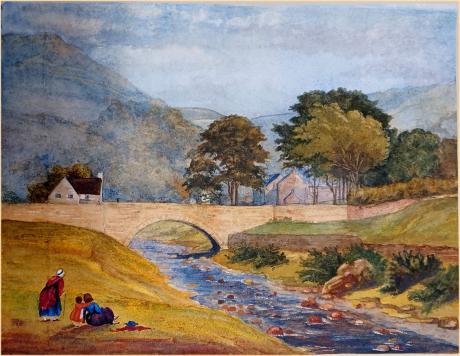signed inscribed and dated
The first Mackerston Bridge crossing the Gogo Burn was a wooden bridge built in 1724. It had 4 arches , 2 were occupied by the burn and the other 2 were occupied by pig pens.The bridge was rebuilt in 1832 and 1910 and finally upgraded in 1975. Weavers and their Mills started appearing on the Gogo as early as the 1630's. including Saw Mills Lint, grain dye and wool, most were powered directly by the power of the water on the Gogo. The last survyving Mill still standing and depicted in this watercolour is the Gogo Mill which was built around 1633. the Mill and its adjoining buildings can be found in the backyard of the Jewsons Building store on Irvine Road. John Osborne was tenanted here from 1671 -1679. in those days the Gogo Mill was a saw Mill and timber yard as well as a grain Mill. The Mill Wheel was powered by a pond fed by the Gogo burn called Gogoside Lade this is now Milburne Gardens. The Tenant in 1806 was John Beith and by 1834 it was occupied by Whiteford and Morris. From 1867 to 1907 it was occupied by John Johnstone and his family. This was at the time that this watercolour was painted. Opposite the Gogo Mill in Waterside street is a group of buildings which were used by McMillans distillery. The distillery watersupply came from an aqueduct which crossed the Gogo burn beside the Mill on the opposite bank. The distillery lasted until the early 1800's. When the distilling stopped the aqueduct was kept in use and water was divirted down the main street to flush the open sewers that ran down the main street.
Largs is a town on the Firth of Clyde in North Ayrshire, Scotland, about 33 miles (53 km) from Glasgow. The original name means "the slopes" (An Leargaidh) in Scottish Gaelic. A popular seaside resort with a pier, the town markets itself on its historic links with the Vikings and an annual festival is held each year in early September. In 1263 it was the site of the Battle of Largs between the Norwegian and the Scottish armies. The National Mòd has also been held here in the past. There is evidence of human activity in the vicinity of Largs which can be dated to the Neolithic era. The Haylie Chambered Tomb in Douglas Park dates from c. 3000 BC. Largs evolved from the estates of North Cunninghame over which the Montgomeries of Skelmorlie became temporal lords in the seventeenth century. Sir Robert Montgomerie built Skelmorlie Aisle in the ancient kirk of Largs in 1636 as a family mausoleum. Today the monument is all that remains of the old Kirk.
From its beginnings as a small village around its kirk, Largs evolved into a busy and popular seaside resort in the nineteenth century. Large hotels appeared and the pier was constructed in 1834. It was not until 1895, however, that the railway made the connection to Largs, sealing the town's popularity. It also became a fashionable place to live in and several impressive mansions were built, the most significant of which included 'Netherhall', the residence of William Thomson, Lord Kelvin, the physicist and engineer.
Largs has historical connections much further back, however. It was the site of the Battle of Largs in 1263, in which parts of a Scottish army attacked a small force of Norwegians attempting to salvage ships from a fleet carrying the armies of King Magnus Olafsson of Mann and the Isles and his liege lord King Haakon IV of Norway, beached during a storm. The Norwegians and islemen had been raiding the Scottish coast for some time, and the Scots under Alexander III had been following the fleet, attempting to catch its raiding parties. The outcome of this confrontation is uncertain, as both sides claim victory in their respective chronicles and sagas and the only independent source of the war fails to mention the battle at all. The battle was followed soon after by the death of the 59 year old King Haakon in Bishop's Palace on Orkney. Following the king's demise, his more lenient son Magnus VI of Norway agreed the Treaty of Perth in 1266, under which the Hebrides were sold to Scotland, as was the Isle of Man after the demise of Magnus Olafsson.
The Largs war memorial dates from 1920 and was designed by Sir Robert Lorimer.During World War II, the Hollywood Hotel was designated HMS Warren, which was Headquarters, Combined Training. A conference was held there between 28 June 1943 and 2 July 1943, code name RATTLE, under Lord Louis Mountbatten. It was known as the "Field of the Cloth of Gold" (named after a famous historic event) because of the number of high-ranking officers taking part. The decision that the invasion of Europe would take place in Normandy was made at this conference.[4] King Haakon VII of Norway, then in exile in Britain due to the German occupation of his kingdom, visited Largs in 1944 and was made the town's first honorary citizen. Largs was (from the summer of 2017) the first place in the world to introduce a fully integrated system to activate pedestrian crossings using a series of Neateboxes. This system allows visually or physically impaired persons to activate the crossing button with no actual requirement to find or push the button, and will be of great benefit to the disabled community.

